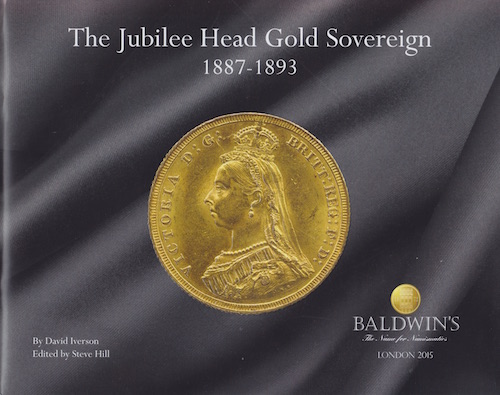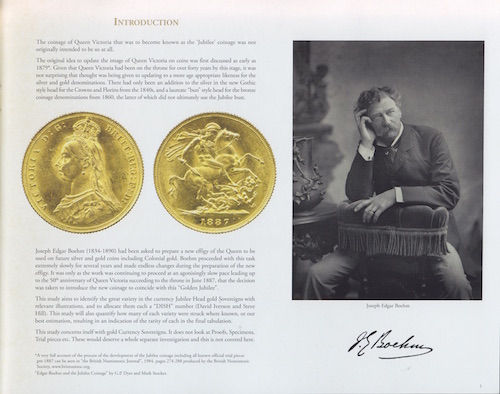A Ground-Breaking Document Has Been Published on Australia's Jubilee Sovereigns

The document I’m referring to isn’t specifically about “Australian” sovereigns, but was written on the British sovereigns featuring Joseph Edgar Boehm’s “Jubilee” portrait of Queen Victoria, stuck by the Royal Mint between 1887 and 1893. The brochure is called “The Jubilee Head Gold Sovereign”, and has been written by David Iverson and Stephen Hill. (Click that link to read it online.)
As the mints located in Australia at that time (Sydney and Melbourne) were branches of the Royal Mint (and were not “Australian” mints per se), they are also covered by this document. If you haven’t already guessed it, the document was published in London, and was written by two of the most experienced numismatists in the world in this series.

The stated aims of the publication are to identify the various varieties of the Jubilee Head sovereign, and to also quantify just how rare each of those varieties might be expected to be.
For mine, the publication also adds a great deal more human interest to this sovereign series - the brochure makes reference to a great deal of correspondence between the most important figures involved with the design and production of these coins, and even includes images of that correspondence, bringing the stories behind them vividly to life.
The Authors David Iverson and Stephen Hill
When he attends auctions in the UK, David Iverson has been referred to by some folks as “The Jubilee Head Sovereign Man”, which should be taken as being some acknowledgement of his dedication to this area of numismatics. David has collected Jubilee sovereigns for some time now, and he wasn’t satisfied when certain questions of his regarding differences in the obverse of certain Jubilee-head sovereigns weren’t answered satisfactorily. Rather than simply accept these explanations, he decided to answer them himself. That resilience and attitude led to the publication of this booklet.
I was interested to read that David was attracted to the Jubilee Head sovereign series for exactly the same reason many Australian collectors choose it - the coins were only struck across a s`even year period, which means the total number of coins in the set is quite achievable.
Stephen Hill is a Director of the London numismatic auction house and dealer, Baldwin’s. Stephen specialises in English, Scottish and Irish milled and hammered coins and has a good general knowledge of many other areas. Additionally he has dealt in tokens and commemorative medals in the last decade of the 20th Century. Stephen facilitated David’s research, and edited the publication as well.
The Background to Boehm's Design
Although the background to the issue of the Jubilee Head portrait had been explored in great detail in the British Numismatic Society Journal in 1984, this publication does point out that the designer of the Jubilee Head portrait, Joseph Edgar Boehm, certainly took his time in arriving at the finished product. Queen Victoria had her first sitting with Boehm in June 1879, yet the first sovereigns featuring this portrait were not released into circulation until June 1887!
That there was a widespread negative response to the Jubilee portrait is now well known. The most pointed reaction was from Sir Charles Oman, a noted British historian and President of the Royal Numismatic Society, who described it as being no less than “The greatest disappointment of the century."
Whatever the reaction of the general populace was to Boehm’s design, it is regarded by collectors as just another of the noble designs in the British / Australian Sovereign series.

The Jubilee Head Sovereigns of the Sydney Mint
The slow timeline that the Jubilee sovereigns were struck under is no better illustrated than by the fact that although the Sydney Mint intended to release sovereigns with the new Jubilee portrait as soon as was practical after Victoria’s coronation date of June 20th, the Royal Mint did not dispatch dies to them until April 12th, 1887.
Iverson’s brochure is invaluable to Jubilee Head sovereign collectors for a number of reasons, not least because it finally(!) explains why there are a number of seemingly inconsequential differences in the designer’s initials on the truncation of Victoria’s portrait on these coins. It turns out that production was under such pressure to be complete in time for the celebrations for the anniversary of Victoria’s accession. It turns out that these letters were manually punched onto each die by a mint staffer named William Poppett. Given the number of dies used to strike the Jubilee sovereign, it is perhaps surprising there are not more design variations than is now known.
An aside within this section of the brochure sheds new light on the mintage figure of the 1887 Sydney half sovereign with the Young Head portrait, and the reason why they were struck.
The second major contribution of this brochure to our knowledge of the series is the cause of the difference in the obverse legends has now been explained. Iverson makes reference to concerns that several members of the Royal Mint staff (Leonard Wyon among them) had regarding the “metal flow” the new obverse would cause. Although no written sources are cited, Iverson and Hill make no bones that the second legend type (where the distance between the Queen’s portrait and the colon after “G” in the obverse legend is far closer than on the first legend type, and the tip of the crown blends into the denticles around the edge of the coin) was introduced as a solution to this potential problem.
Iverson’s statistical analysis of the die register for Sydney in 1887 leads him to believe (quite logically) that the actual mintage of the 1887 Sydney Jubilee sovereign (long regarded as the rarest date in the entire Jubilee sovereign series), is in fact a third of what it has been regarded previously.
The Jubilee Head Sovereigns of the Melbourne Mint
Iverson points out that the Melbourne Mint staff requested more Jubilee Head sovereign dies just 3 days after the new sovereigns began to be released into circulation. The use of these extra dies explains the relative rarity of the 1887 Sydney Jubilee sovereign to the1887 Melbourne Jubilee sovereign.
Quantified Rarity, Year by Year
Making use of the die register records held by the Royal Mint, and comparing them to the dates of each production run, Iverson has been able to not only approximate how many of each variety was struck, but also the dates across which they were struck - the type of information many collectors just love to sink their teeth into.
This quantified rarity applies not only to the different obverse varieties, but also to the different reverse varieties - long and short tail.
In major news, the authors pointedly debut the existence of the medium tail variety, stating that they believe it to exist due to wear in certain dies, and not due to any particular design changes. Just whether this opinion will gain traction in Australia, where each of the three tail varieties have been accepted for some time, remains to be seen. If collectors can be satisfied that the medium tail difference is indeed only due to worn dies, I can see interest in them waning, relative to the other design variations.
The Appendix - Mintage Figures and Approximated Rarity by Date and Type
The Appendix is where the authors really fly their flag - the rarity of each and every variety is approximated by date. The authors have also demonstrated how rare certain varieties are relative to others in the same year - this accessible information I believe will have a significant impact on the values that varieties within the same year have relative to each other. To use the 1888 Melbourne sovereign as an example, Iverson and Hill show how the mintage of the Legend One variety is most likely just 1% of the total mintage of Jubilee sovereigns at the Melbourne Mint that year - that simply has to have an impact on the prices that collectors will ask for their coins!
My verdict on “The Jubilee Head Gold Sovereign” by David Iverson and Stephen Hill is that it is an excellent, and indeed a compulsory read for anyone that collects Australian sovereigns. It is a significant contribution to the study and enjoyment of this ever-popular sovereign series, and will be sure to inject another round of enthusiasm into the market for these coins.
